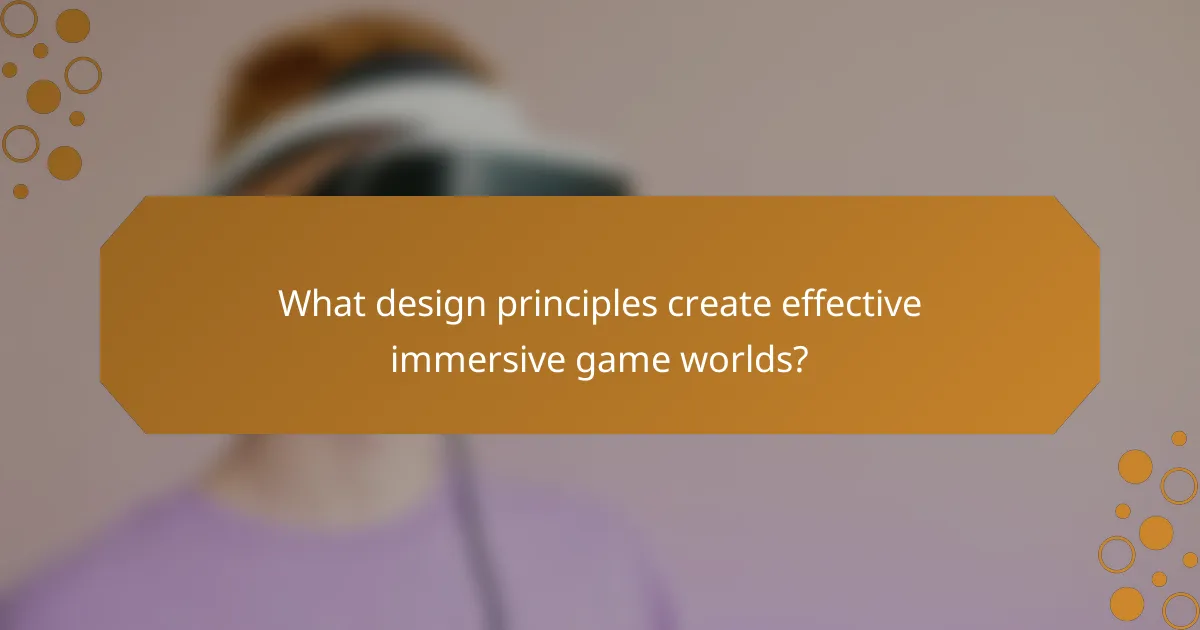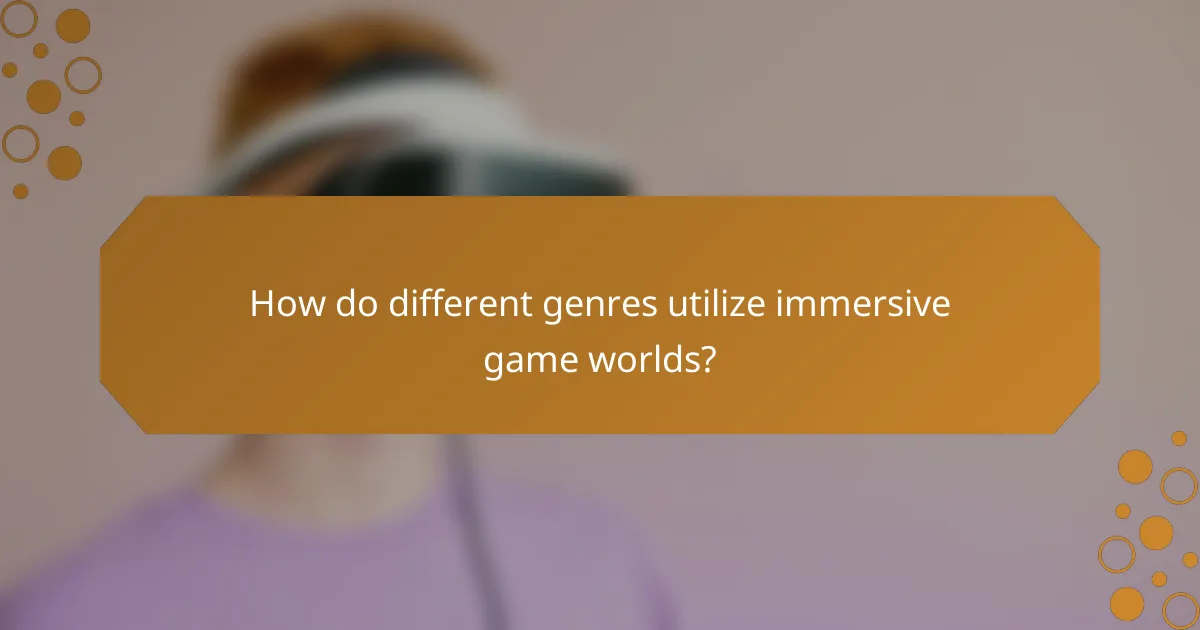Immersive game worlds are designed to captivate players by fostering exploration, interaction, and emotional connections within richly crafted environments. By integrating principles such as environmental storytelling, player agency, and stunning visual aesthetics, these worlds transform players into active participants. Technologies like virtual reality, augmented reality, and artificial intelligence further enhance this engagement, creating realistic and interactive experiences that draw players deeper into the game.

How can immersive game worlds enhance player engagement?
Immersive game worlds enhance player engagement by creating rich environments that encourage exploration, interaction, and emotional connection. These worlds draw players in, making them feel like active participants rather than mere observers.
Increased interactivity
Increased interactivity in immersive game worlds allows players to influence the game environment and narrative through their actions. This can include solving puzzles, making choices that affect story outcomes, or engaging in dynamic combat systems.
For example, games like “The Legend of Zelda: Breath of the Wild” offer players the freedom to approach challenges in various ways, enhancing their sense of agency. Developers should focus on creating responsive environments that react to player decisions to maximize interactivity.
Emotional investment
Emotional investment is crucial for player engagement, as it fosters a deeper connection to the game’s characters and story. When players care about the outcomes of their actions, they are more likely to remain engaged and invested in the gameplay experience.
Story-driven games such as “The Last of Us” effectively build emotional ties through character development and narrative depth. To cultivate emotional investment, developers should prioritize storytelling elements that resonate with players’ experiences and feelings.
Social connections
Social connections in immersive game worlds enhance player engagement by fostering community and collaboration. Multiplayer environments allow players to form friendships, share experiences, and work together towards common goals.
Games like “World of Warcraft” exemplify this by creating guilds and cooperative quests that encourage social interaction. Developers should incorporate features that promote teamwork and communication, such as in-game chat systems and shared objectives, to strengthen social ties among players.

What design principles create effective immersive game worlds?
Effective immersive game worlds are built on principles that enhance player engagement and interaction. Key elements include environmental storytelling, player agency, and visual aesthetics, all of which contribute to creating a believable and captivating experience.
Environmental storytelling
Environmental storytelling involves using the game world itself to convey narrative elements without explicit dialogue. This can include details like the arrangement of objects, background lore, and visual cues that hint at past events or character motivations.
Designers should consider how every element in the environment can tell a story. For example, a dilapidated building might suggest a once-thriving community, while scattered personal belongings can hint at the lives of its former inhabitants. This approach encourages players to explore and piece together the narrative organically.
Player agency
Player agency refers to the degree of control players have over their actions and decisions within the game world. High levels of agency allow players to shape their experiences, influencing outcomes and interactions in meaningful ways.
To enhance player agency, designers should provide multiple paths and choices that lead to different consequences. This can be achieved through branching storylines, varied character abilities, or open-world exploration. However, it’s crucial to balance freedom with structure to avoid overwhelming players.
Visual aesthetics
Visual aesthetics encompass the artistic style and graphical quality of the game world, significantly impacting player immersion. A cohesive and appealing visual design can draw players in and enhance their emotional connection to the game.
When developing visual aesthetics, consider the target audience and the desired atmosphere. For instance, a vibrant, colorful palette may suit a lighthearted adventure game, while a darker, more muted tone might be appropriate for a horror title. Consistency in style across all elements, from characters to environments, is essential for maintaining immersion.

Which technologies drive interaction in immersive game worlds?
Key technologies that drive interaction in immersive game worlds include virtual reality (VR), augmented reality (AR), and artificial intelligence (AI). Each of these technologies enhances player engagement by creating more realistic and interactive environments.
Virtual reality (VR)
Virtual reality immerses players in a fully digital environment, allowing them to interact with the game world through headsets and motion controllers. This technology creates a sense of presence, making players feel as though they are truly inside the game.
When designing VR experiences, developers should focus on minimizing motion sickness by maintaining a high frame rate and ensuring intuitive controls. Popular VR platforms include Oculus Rift, HTC Vive, and PlayStation VR, each offering unique features and game libraries.
Augmented reality (AR)
Augmented reality overlays digital elements onto the real world, enhancing the player’s environment with interactive features. This technology allows players to engage with both physical and virtual objects simultaneously, creating a blended experience.
AR applications, such as Pokémon GO, demonstrate how players can explore their surroundings while interacting with digital characters. Developers should consider the accessibility of AR technology, as it often relies on smartphones or tablets, making it essential to optimize for various devices.
Artificial intelligence (AI)
Artificial intelligence enhances interaction in immersive game worlds by enabling non-player characters (NPCs) to respond intelligently to player actions. AI can create dynamic narratives and adaptive gameplay, making each player’s experience unique.
When implementing AI, developers should focus on creating believable behaviors and decision-making processes for NPCs. Techniques such as machine learning can be employed to improve NPC responses over time, leading to more engaging and lifelike interactions for players.

What are the best practices for designing player interactions?
Effective player interactions are crucial for engaging immersive game worlds. Best practices include creating intuitive feedback loops, adapting content dynamically, and ensuring accessibility for all players.
Feedback loops
Feedback loops are essential for reinforcing player actions and decisions. They provide immediate responses to player inputs, helping to create a sense of agency and immersion. For example, visual or auditory cues can indicate successful actions, while failure states can prompt players to adjust their strategies.
When designing feedback loops, consider the timing and clarity of the responses. Aim for feedback that occurs within low tens of milliseconds to maintain engagement. Avoid overwhelming players with excessive information; instead, focus on clear, concise signals that guide their next steps.
Dynamic content adaptation
Dynamic content adaptation involves tailoring game experiences based on player behavior and preferences. This can include adjusting difficulty levels, changing narrative paths, or modifying in-game environments. Such adaptability keeps players engaged by ensuring that challenges remain appropriate for their skill levels.
Implementing dynamic content requires robust data tracking and analysis. Use player metrics to inform adjustments, ensuring that changes enhance the gaming experience without frustrating users. For instance, if a player struggles with a particular level, consider offering hints or reducing difficulty temporarily.
Accessibility features
Incorporating accessibility features is vital for making games enjoyable for a broader audience. These features can include customizable controls, text-to-speech options, and visual aids for players with disabilities. Ensuring that all players can engage with your game enhances overall satisfaction and expands your player base.
When designing for accessibility, follow established guidelines such as the Web Content Accessibility Guidelines (WCAG). Consider conducting user testing with diverse groups to identify potential barriers. Simple adjustments, like color contrast enhancements or subtitle options, can significantly improve the experience for many players.

How do different genres utilize immersive game worlds?
Different game genres leverage immersive worlds to enhance player experience, engagement, and interaction. Each genre employs unique design elements and mechanics to create environments that resonate with players, fostering deeper connections and gameplay satisfaction.
Role-playing games (RPGs)
RPGs create immersive game worlds by allowing players to inhabit detailed characters and narratives. These games often feature expansive environments filled with lore, quests, and interactive NPCs that respond to player choices, enhancing the sense of agency.
Key elements include character customization, branching storylines, and rich world-building. For example, games like “The Witcher” and “Final Fantasy” offer vast landscapes and intricate plots that encourage exploration and emotional investment.
First-person shooters (FPS)
FPS games utilize immersive worlds to enhance realism and tactical gameplay. The environments are designed to be visually striking and strategically complex, often featuring destructible elements and dynamic lighting to create an engaging atmosphere.
Players experience the action through the character’s perspective, which heightens immersion. Titles like “Call of Duty” and “Battlefield” emphasize fast-paced action in detailed settings, where players must adapt to their surroundings for effective combat.
Simulation games
Simulation games focus on creating realistic environments that mimic real-world scenarios, allowing players to engage in activities like building, managing, or exploring. These games often prioritize accuracy in physics and mechanics, enhancing the immersive experience.
Examples include “The Sims” and “Cities: Skylines,” where players can manipulate environments and systems. Effective simulation games encourage experimentation and creativity, providing feedback that reflects player decisions in a lifelike manner.

What metrics measure player engagement in immersive games?
Player engagement in immersive games is typically measured using metrics such as session length, retention rate, and player interactions. These indicators help developers understand how players interact with the game world and how invested they are in the experience.
Session Length
Session length refers to the duration players spend in a game during a single play session. Longer session lengths often indicate higher engagement, as players are more likely to explore the game world and participate in its activities. Developers should aim for average session lengths that exceed 30 minutes, as this suggests players are invested in the gameplay.
To enhance session length, consider incorporating compelling storylines, rewarding gameplay mechanics, and engaging environments. Avoid repetitive tasks that may lead to player fatigue and disengagement.
Retention Rate
Retention rate measures the percentage of players who return to the game after their first session. High retention rates, particularly after the first day and week, indicate strong player engagement and satisfaction. Aiming for a retention rate of around 40-60% after one week is a common benchmark for successful immersive games.
To improve retention, implement features such as daily rewards, regular updates, and community events. These strategies encourage players to return and continue their journey within the game world.
Player Interactions
Player interactions encompass various activities, including social interactions, in-game purchases, and participation in events. High levels of interaction suggest that players are engaged and invested in the game. Tracking metrics such as the number of social interactions or purchases can provide insights into player behavior.
Encourage player interactions by creating social features, such as guilds or cooperative missions, and offering incentives for in-game purchases. However, balance monetization strategies to avoid alienating players who may feel pressured to spend money.



